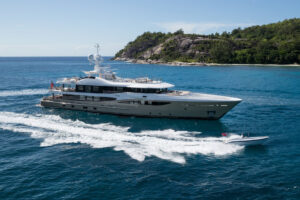
A combination of factors has created a burst of two-person and small-family voyaging on boats as big as 60 or 70 feet length overall.
First, there’s the COVID-19 pandemic, which has all kinds of boaters looking to get on the water for socially distanced fun with few or no crew. Next are newer yacht designs that improve accessibility and features for small crews, making short-handed cruising easier. Third is the rapid growth of technology and equipment supporting short-handers: Bow and stern thrusters can “pin” a yacht to the dock while lines are put ashore; warping winches can turn the average boaters into Olympic weightlifters when it comes to hauling dock lines; and a second set of helm controls or remote controls can give a skipper full command of the boat from pretty much anywhere aboard.
But having the right boat and equipment is just the start of creating a great short-handed cruising experience. A short-handed crew needs to be prepared before tossing off the dock lines—and the best way to prepare is to take baby steps. Start small. An overnight trip to a nearby island, or even practicing getting into and out of a home slip in various conditions, will give a short-handed crew the confidence to venture farther afield.
As those plans evolve and a cruising plan takes shape, preparation is key. Coil down dock lines that will be needed. Have a breast line or spring line ready to go because it can save even the most skilled skipper during a sketchy docking scenario. Check out unfamiliar docks before tying up at them, and hang plenty of fenders, both horizontally and vertically, for full vessel protection.
Don’t wait until entering an unfamiliar harbor to look at charts—study them in advance. Like a racecar driver memorizing the turns on a track, know the destination, understand where to anchor or dock, and note potential hazards. Longtime short-handers will fill a notebook for each destination, to have tips at the ready for the next arrival. Having a printed marina map will help when the harbor master radios instructions to take slip F7.
Before going into an unfamiliar anchorage, wise short-handers stop and drift for a few moments to assess how the wind and current are going to affect the approach. Helmsmen can’t always pick slack water and calm winds when docking, so don’t wing it. Have a clear understanding of how the conditions may require a change of plans in boat handling.
Another key to short-handing is talking through every possible scenario. For example, which is the key dock line to secure first? What happens if the husband misses picking up a buoy while the wife is at the helm? How do you handle an anchor that drags? When there are just two people aboard, everyone should be clear on the tasks at hand to avoid “I thought you were doing that” moments.
Ideally, noise-canceling headsets and mics can help here, as can hand signals practiced beforehand.
And speaking of equipment, most short-handers also have a basic rule: Never leave the cabin without wearing a life jacket. If the weather is the least bit rough, it should be a life jacket with a harness to snap into a jackline running along the deck for added safety.
Special precautions should also be taken while running short-handed at night. First, decide on a watch system and stick to it. Some crew prefer three and three (three hours on, three hours off) all night, while others (especially in rough weather) like two and two. Racing yachts sometimes use four-four-four at night then six and six during the day when it’s easier to stay alert.
Whatever the choice, the second person aboard should always be available. A pilot berth tucked abaft the helm can be great, allowing the off-watch person to be roused quickly, if needed.
On the other hand, if the off-watch person gets to sleep soundly, the change of watch must include a debrief of the current situation. This includes talking about the boat’s course, the weather conditions and anything unusual, such as a shipping freighter in the distance. Odd lights on the horizon. VHF radio chatter. All of it.
Also, take care to preserve everyone’s night vision. Low lighting around the helm must be maintained because full night vision can take hours to return. Use spotlights or flashlights as a last resort. One short-handed skipper I know would wear a pirate-style patch over one eye, using only the other eye when he went into a lighted cabin for coffee or whatever and then removing the patch when he was back in the dark to keep night vision in one eye.
Heading to the galley also requires some different thinking while cruising short-handed. Don’t plan on spending hours cooking meals in the galley underway; instead, prepare meals beforehand and make them easy to eat. Sandwiches are a one-handed food, as are soups or stews poured from a thermos next to the helm into a warming mug.
Snacks will get short-handers through the night, but stay away from sugar with all the highs it creates. Think fruit bars, bowls of nuts or even quartered sandwiches.
During the day, there is more galley time, but have vacuum-bagged, precooked meals prepared at home (or in an anchorage) that can be microwaved or immersed in hot water for a quick warmup.
However, if conditions permit, the smell of coffee brewing and bacon sizzling can be the perfect end to a long night watch and the great start to a morning in a lovely anchorage with precious few other people around.
Equipment as an Extra Hand
Nearly every short-handed skipper can make use of bow and stern thrusters when docking. “We use Glendinning proportional hydraulic thrusters,” says Jeff Druek, president of Outer Reef Yachts, “so we can nail the boat alongside the dock while you get the lines on. They’re a huge, huge plus.”
Beyond hydraulics, look for thruster joysticks that can be locked in the “on” position while the skipper leaves the helm to handle lines.
Docking Tips
One single-hander I know always has a “messenger line” with a monkey fist on the end, ready to throw. With practice, anyone can lob this setup 40 feet or more, allowing the crew to get a line ashore to save an awkward situation.
If would-be helpers are on the dock, discourage those who look like they lack line-handling experience. Even better, throw the loop end of a dock line and just have them drop it on a cleat.
Choose the Right Boat
California yacht broker Jeff Merrill of Merrill Yacht Sales tells clients, “Choose the smallest boat that is big enough to accomplish your cruising goals.” There’s no need for a yacht with transoceanic range if your destinations are nearby offshore islands.
Look for wide side decks to move fore and aft easily while docking, as well as pilothouse doors to port and starboard for quick deck access. Remote helm controls (or walk-around plugged or cordless controls) can simplify everything from Med-style mooring to anchoring.
Listen Up
Every boater has witnessed couples shrieking at each other while docking, but today’s communications technology can solve that problem. Several manufacturers, such as Eartec and Sena, offer headsets with a single earphone (allowing regular hearing through the other ear) and a microphone for all-weather communications. Vokkero makes headsets for sports coaches and is now providing headsets for sailors on America’s Cup yachts.
Final Tips
Safety First, Always—Never leave the cabin without wearing a life jacket. If the weather is the least bit rough, it should be a life jacket with a harness to snap into a jackline running along the deck for added safety.
Seeing Through the Dark—Take care to preserve everyone’s night vision. Low lighting around the helm must be maintained because full night vision can take hours to return.
Know Before you Go—Don’t wait until entering an unfamiliar harbor to look at the charts—study them in advance. Like a racecar driver memorizing the turns on a track, know the destination.
Push Pause, then Proceed—Before going into an unfamiliar anchorage, wise short-handers stop and drift to assess how the wind and current are going to affect the approach.








